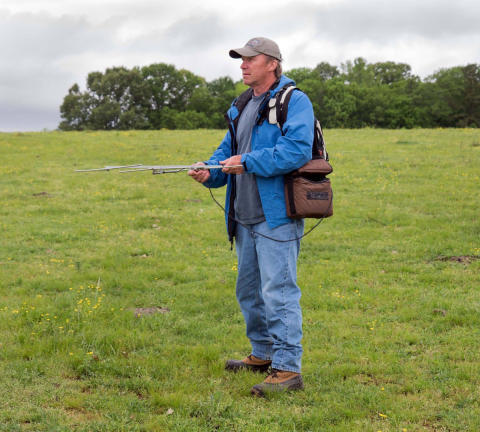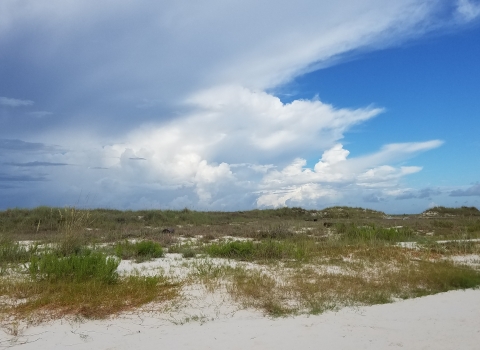After a long career with the Department of Defense, working on multi-million-dollar security programs and weapons systems for the U.S. Armed Forces and with partner nations, serving all over the Southeast and abroad, Tom Ress took refuge.
“I love the outdoors and nature and found myself spending an inordinate amount of free time at Wheeler National Wildlife Refuge, and I thought ‘I can be doing more than this while I’m here,’” said the Athens, Alabama, native.
To that end, more than 16 years ago, he raised his hand to volunteer in the army of others who freely give their time at Wheeler, protecting wildlife natural habitats and educating others about preservation and conservation.
“Here at Wheeler National Wildlife Refuge, volunteers are the face of the refuge,” said David Young, visitor services park ranger. “They are the first smiling face that greets visitors when they walk in our visitor center and are the first friendly voice to answer the phone when they call with questions. Our volunteers help the visiting public connect with the nature found on the Wheeler National Wildlife Refuge Complex.”
Ress claims Wheeler is a “remarkable place.”
He credits that to the diverse habitats found there: wetlands, swamps, mixed hardwood and pine forests and open water that support a wide cross section of eastern wildlife and plants. The refuge sits on the eastern edge of the Mississippi flyway, so it attracts thousands of ducks, geese, sandhill cranes, and endangered whooping cranes. Ress says that on a good day visitors can spot bald eagles, whooping cranes, deer, coyotes, or alligators – perhaps even more.
“Seeing such huge numbers of waterfowl in one place is a spectacular experience that can be found in very few places today,” he says.
For the wildlife and visitors at Wheeler, Ress will do “whatever needs to be done.” That includes working in the visitor center, greeting visitors and providing information; leading birding and kayak tours; conducting waterfowl surveys; inspecting refuge roads and trails for safety hazards; speaking to community groups, sharing his passion for the refuge; and writing and creating informational outreach products, educating others on Wheeler National Wildlife Refuge. He even wrote a book, Images of America: Wheeler National Wildlife Refuge, which chronicles the property’s history.
“Tom brings a wealth of knowledge about birds and participates on a variety of bird counts throughout the year. He is a fantastic speaker, leading birding walks during the winter and kayaking trips on Flint Creek during summer months. Tom is a skilled writer, having worked on countless writing projects for us,” Young explains. “It's hard to capture the breadth of Tom's positive impact.”
And of course, as a member of the Wheeler Wildlife Refuge Association, Ress helps present the annual Festival of the Cranes, an event that draws thousands of visitors to the refuge each year.
Wheeler is considered by some to be one of the best places in the United States to see whooping cranes up close.
“Our visitor center is a busy place during the winter season when waterfowl are here in large numbers. A steady stream of visitors keeps the place lively, and I get to meet and talk with lots of people from all over the world. I enjoy introducing people to the outdoors,” Ress says. “It’s always a thrill to me when I am leading a tour, and I point out a bird they’ve never seen before. I love the delight in their faces when they see a bald eagle or an endangered whooping crane for the first time. The hours I spend on the refuge sharpen my observation skills and increase my understanding and appreciation of nature. I have become a better birder thanks to my volunteer time.”
Both Young and Ress encourage others to volunteer at a refuge. Found throughout the country, and in the Southeast Region, refuges’ needs are as varied as the experiences, skills, and interests the volunteers bring with them.
“Daily I am reminded how grateful I am for our volunteers,” Young says. “Thanks for giving back to the National Wildlife Refuge System. “
For some volunteers, like Ress, there’s mutual benefit to giving time, serving the Service.
“Expose yourself to a new experience; learn about your local national wildlife refuge national wildlife refuge
A national wildlife refuge is typically a contiguous area of land and water managed by the U.S. Fish and Wildlife Service for the conservation and, where appropriate, restoration of fish, wildlife and plant resources and their habitats for the benefit of present and future generations of Americans.
Learn more about national wildlife refuge ; meet interesting people; become knowledgeable about the wildlife around you. I’ve found that visitors to our refuge are very inquisitive and interesting people who are engaging to converse with. You will learn much from them,” Ress says. “I can’t overstate how much volunteering at Wheeler has impacted my life.”
Editor’s note: During National Volunteer Week, the U.S. Fish and Wildlife Service’s Southeast Region celebrates the efforts of generous volunteers who contribute to the agency’s mission of working with others to conserve, protect, and enhance fish, wildlife, plants, and their habitats for the continuing benefit of the American people. For more information on volunteer opportunities, go to https://www.fws.gov/volunteer-opportunity .





